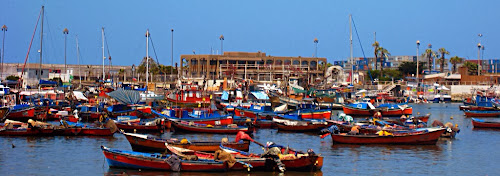On the map, Hospicio looks like a suburb of the town. The cartographers have even given it the same bold graphics as the parent, which might suggest a conflict for supremacy or superiority. Could be a story here. The first views as we come over the Cordillera Litoral, the coastal hills, suggest an industrial town rather than the advertised resort, even if the far edge is etched by a distant heat hazed sea. It appears, as the usual commercial belts start to girdle the pueblo. The tyre repair and oil changers, the alojamiento camiones and dubious moteles, literally lorry hotels and love rooms'. Queued out gas stations and out of-town mercados. All with their loyalty cards, the support industry for copper-town. Our road held in place by crash crumpled barriers and a berm of predatory drifting grit mixed through with societal effluvia. An unprepossessing spectacle for what the guide book says is a premier destination. Through this we tread, waiting for the seashore to materialise, craving the novelty of salt water after two months of high mountain and dry pampa.
The road swings through another bend, and there, below, is Toy Town; the Lilliputian parent-burb of Iquique. Only between here and there is one single sand dune and two thousand, six hundred feet of drop. Perched, like the swirling litter of gyrating vultures that float around us, their spirographing shadows rolling across the hillside, we too launch over the edge. In much the same way that the parapenters do, only we stay true to the reality of terra firma. Then I'm over taken by a child on a mountain bike and a Lycra-clad on a racer. Still, I remain true to the reality of rim brakes. Feels like we could be heading down into an adrenaline zone.
However, what is intriguing me, as my fingers cramp on the brake levers, is the disproportion in the ascending to descending traffic. People are leaving the coast; this on a Sunday, begging the question: what have we missed behind us? A fiesta, a parade or dinner with Granny? Then remembering that this a prime tsunami shore line. A fact that is emphasised as we cross the first intersection at the bottom of the hill. A large yellow warning sign pointing the way we've just come.
If Potosi was the source of all the wealth that financed the Spanish empire, and as a consequence spurred the other European states into expansionist exploration, then Iquique is the source of the raw material that facilitated one of the major expansions in Western agriculture. Bagged nitrogen. The magic jab that could turn a field to verdant green, treble output and send the peasant serf into the fetid slums of the industrial city.
This city started life as a mere indigenous fishing village, gaining a silver mine in 1730, growing with guano extraction, until it became the largest per capita consumer of Champagne in the world. The hedonistic days of the 'Chilean Nitrate' boom, that saw the barons build their mansions and swallow the plonk. The fact that these edifices are available for restoration, and not swamped by 'quake tides or condominiums, is surprising. That one street of these part-restored buildings is pedestrianised, along which no car ever travels, is a testament to civic pride. An history story that I would not have found had I not been forced into an extended stay, predicated by a cycle crash.
Having shuttled the bikes back from the accident site, I've selected an hostel one block from the hospital. Chosen for it's proximity of course, and not it's prominent position in the "shoestring guide". That's a given, a tiger can't change it's stripes. It's in the old home of the immigrant Italian Cuneo family, shop traders from the 'nitrate era'. It's a bit worn around the edges, but still retains some individuality, that is part travelers lodge, part old folks home. It's a base for visit duty and city wandering. A bed to be woken from at four in the morning by the maroon going off. Tsunami warning or adrenal testing?
A city of split personalities. The industrial dirty secret looming on top of the dune, spliced by that dune to the tinted glaze of a financial quarter, then down the historical corridor, by the port to the oceanside. Fuel tankfarms, colonnaded mansions, fishmeal stink, baked flesh.
As happens so often, this is an example of a place that, at first encounter, seemed to lack any personal interest, just another seaside town of adrenaline sports, that with a little time, provided rewards. But not the 'rush' we would have voluntarily chosen.



